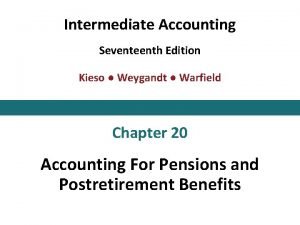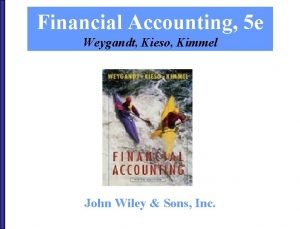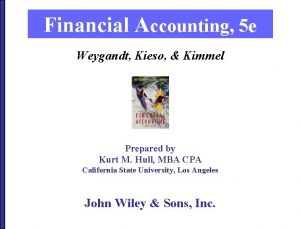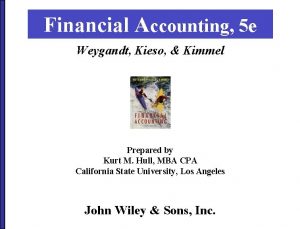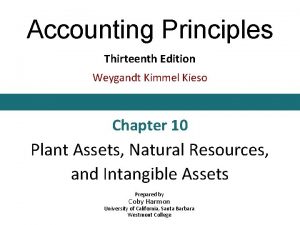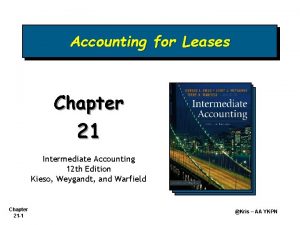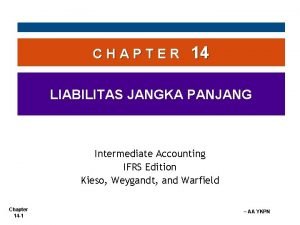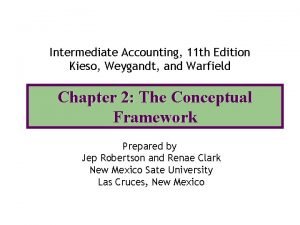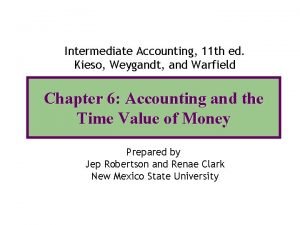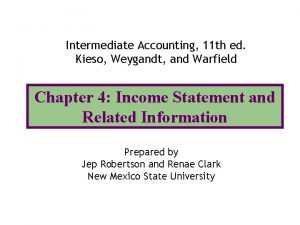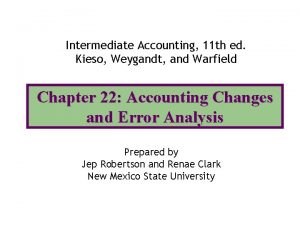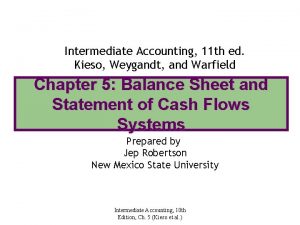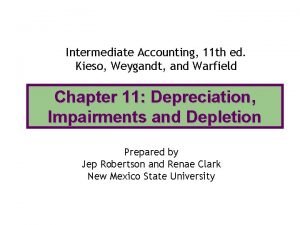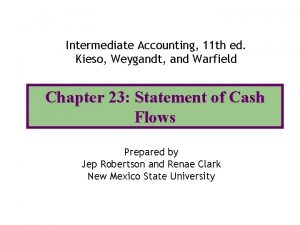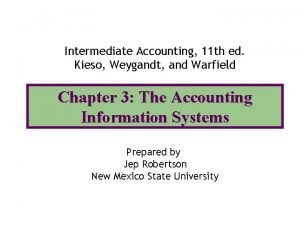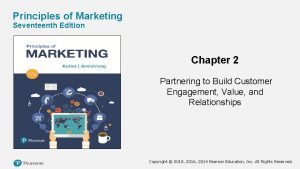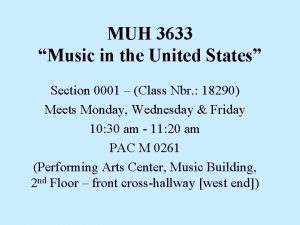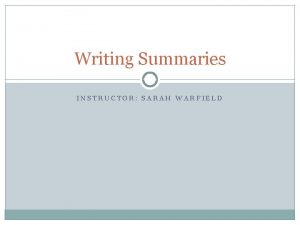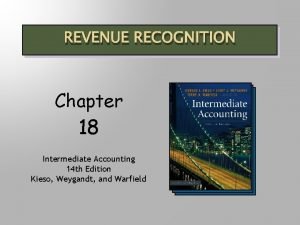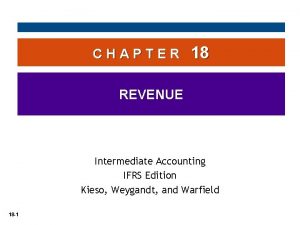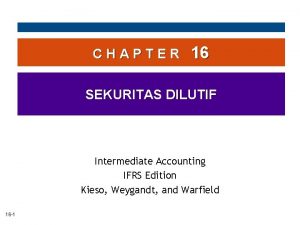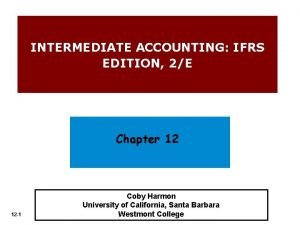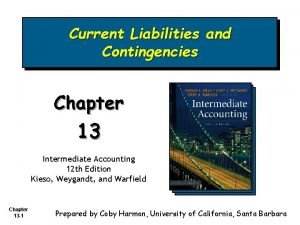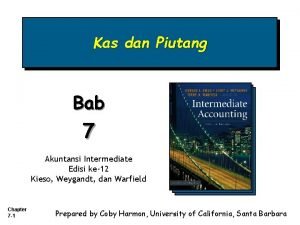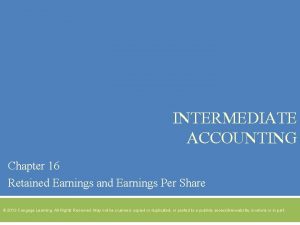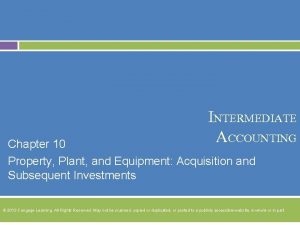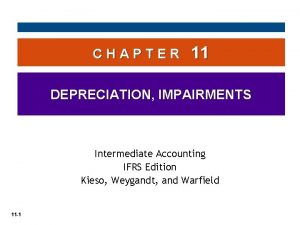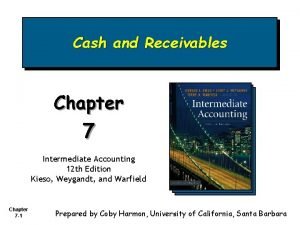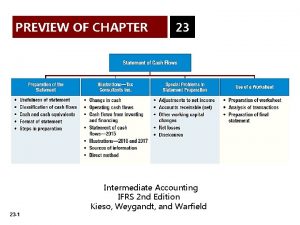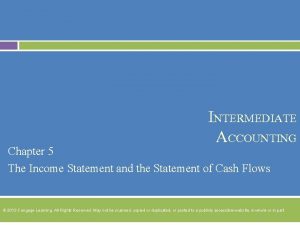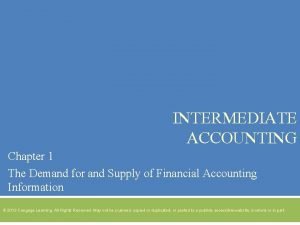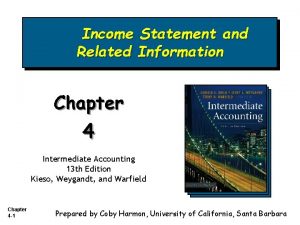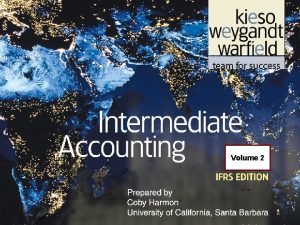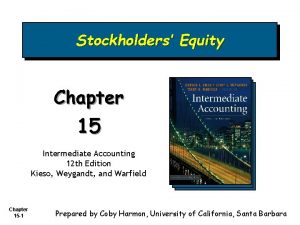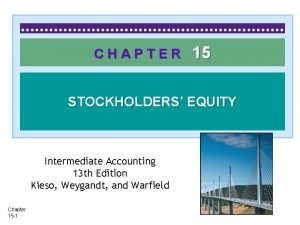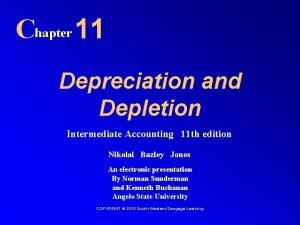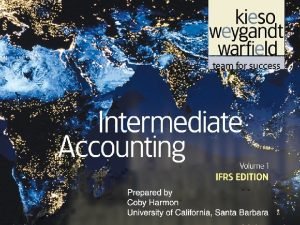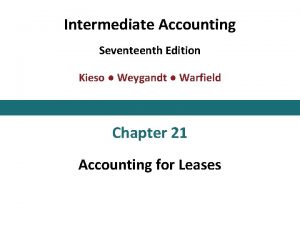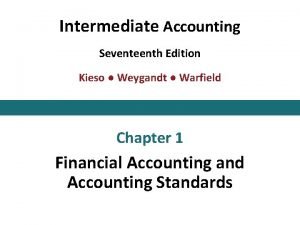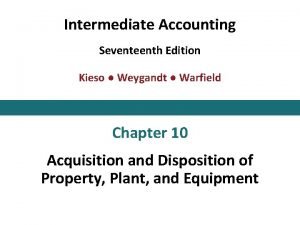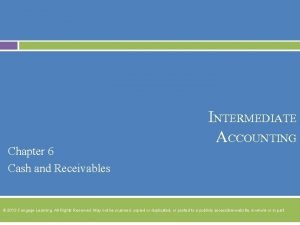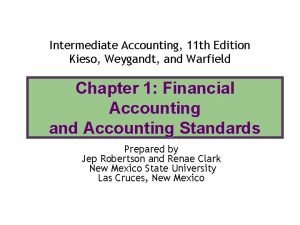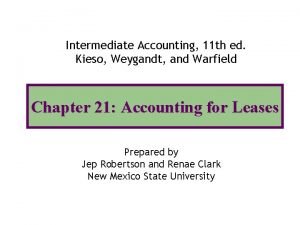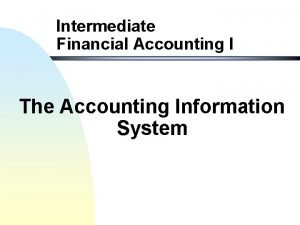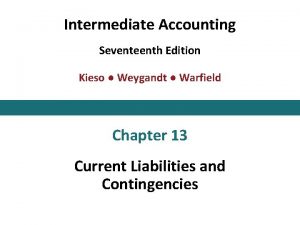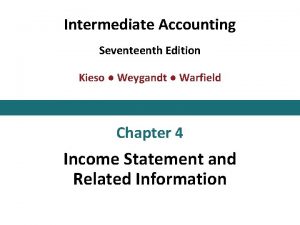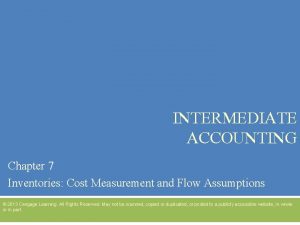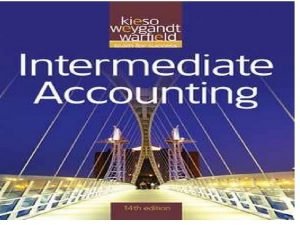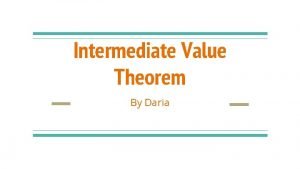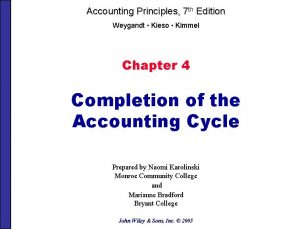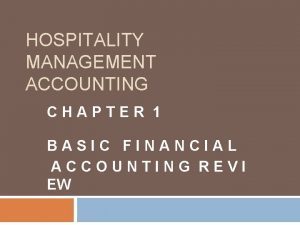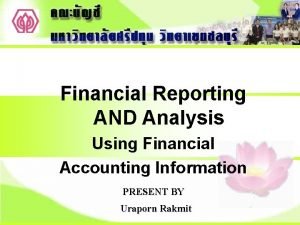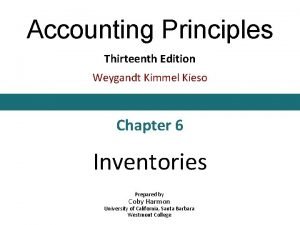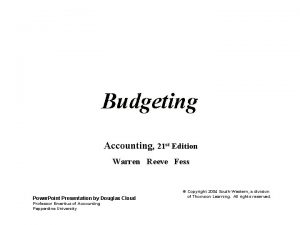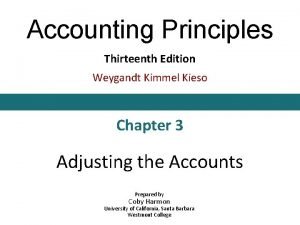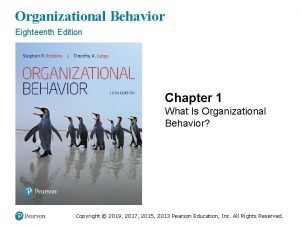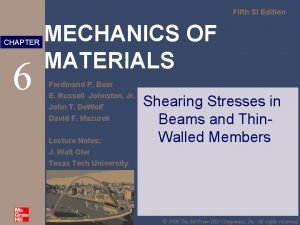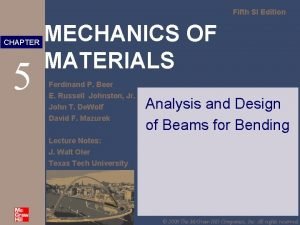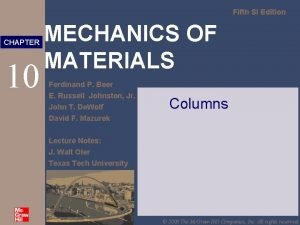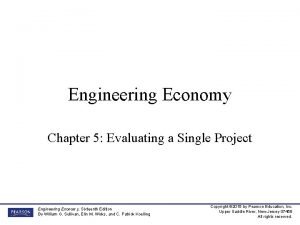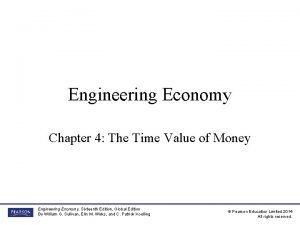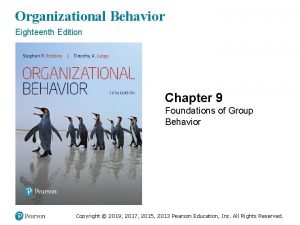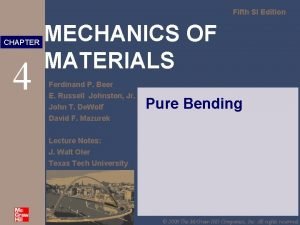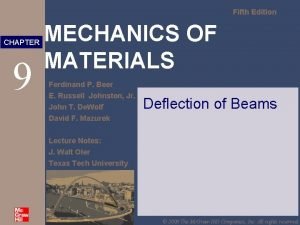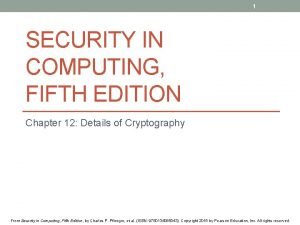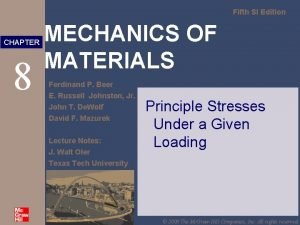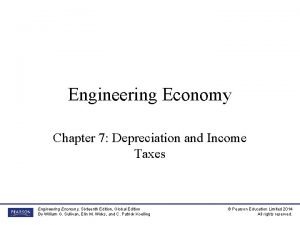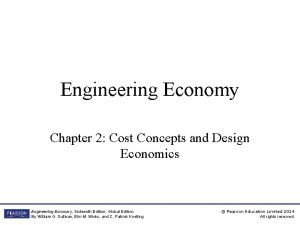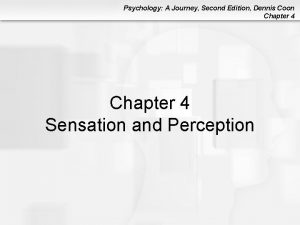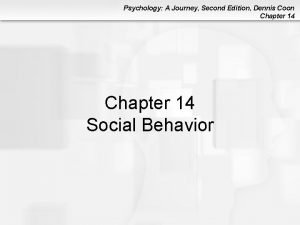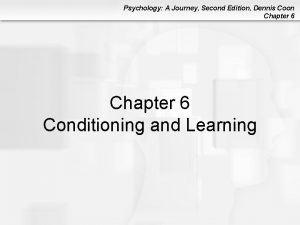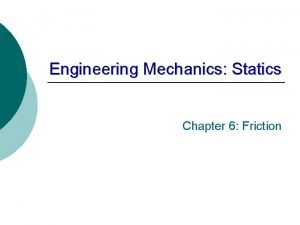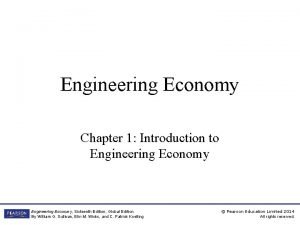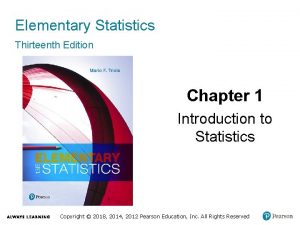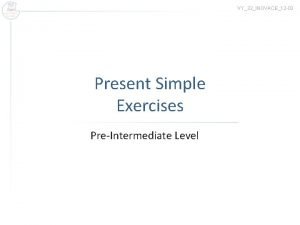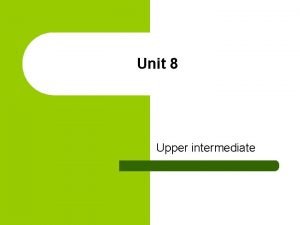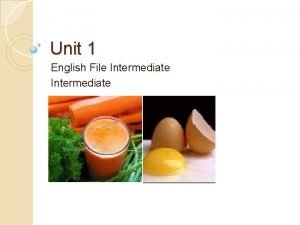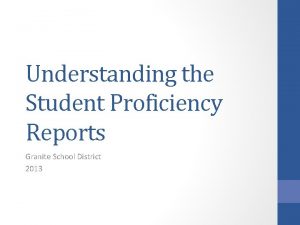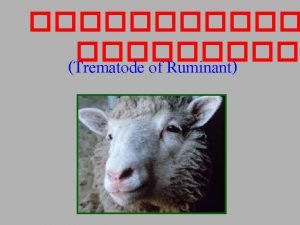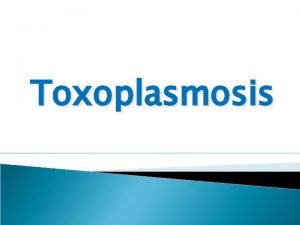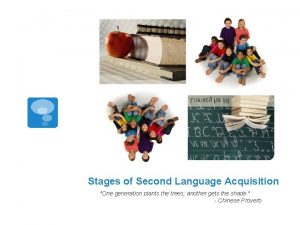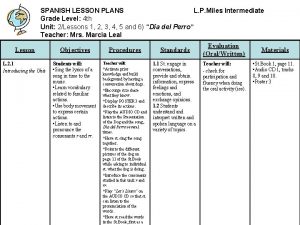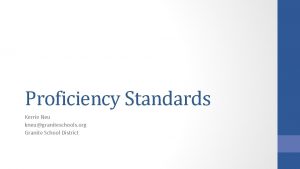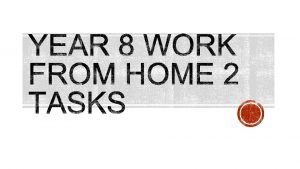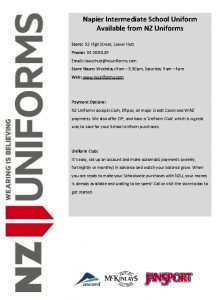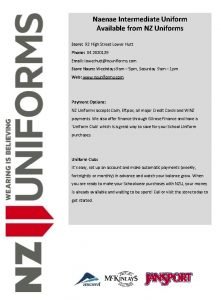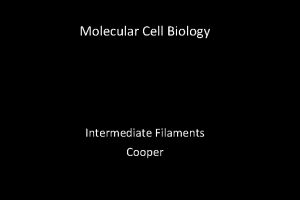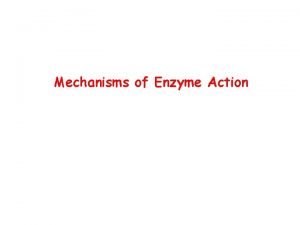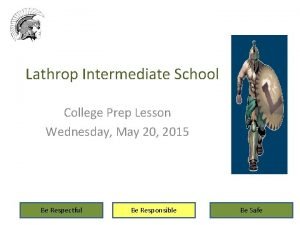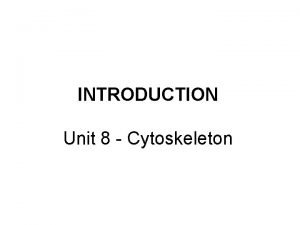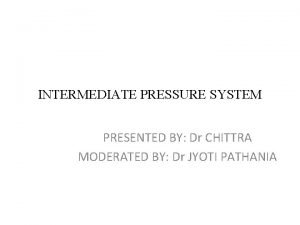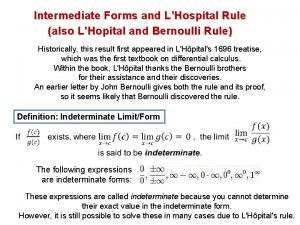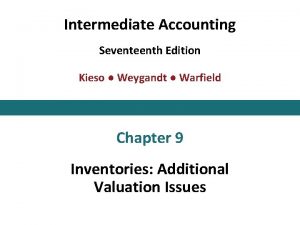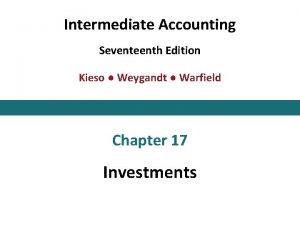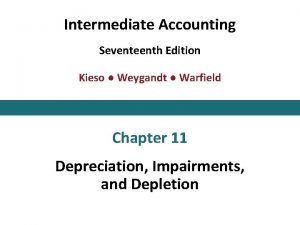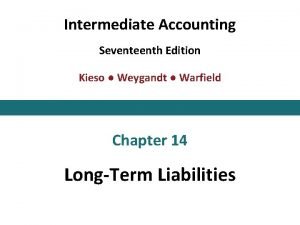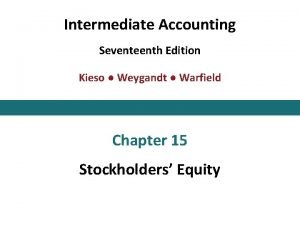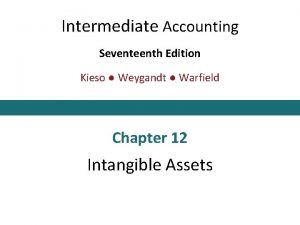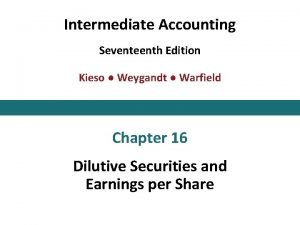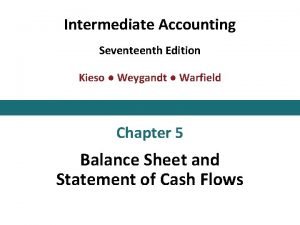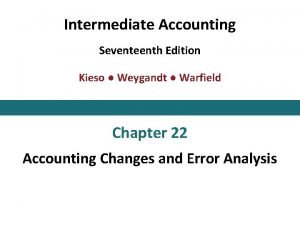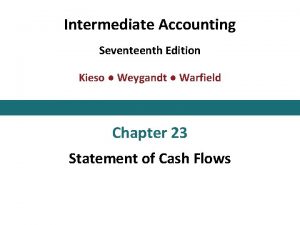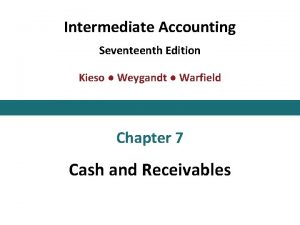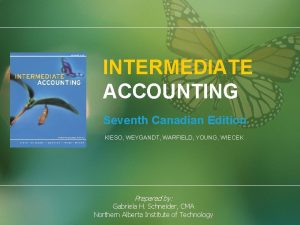Intermediate Accounting Seventeenth Edition Kieso Weygandt Warfield Chapter

























































































































































- Slides: 153

Intermediate Accounting Seventeenth Edition Kieso ● Weygandt ● Warfield Chapter 18 Revenue Recognition This slide deck contains animations. Please disable animations if they cause issues with your device.

Learning Objectives After studying this chapter, you should be able to: 1. Discuss the fundamental concepts related to revenue recognition and measurement. 2. Explain and apply the five-step revenue recognition process. 3. Apply the five-step process to major revenue recognition issues. 4. Describe presentation and disclosure regarding revenue. Copyright © 2019 John Wiley & Sons, Inc. 2

Preview of Chapter 18 Revenue Recognition Fundamentals of Revenue Recognition • • Background New revenue recognition standard Overview of five-step process: Boeing example Extended example of five-step process: BEAN Copyright © 2019 John Wiley & Sons, Inc. 3

Preview of Chapter 18 Revenue Recognition The Five-Step Process Revisited • • • Identifying the contract with customers Identifying separate performance obligations Determining the transaction price Allocating the transaction price Satisfying performance obligations Copyright © 2019 John Wiley & Sons, Inc. 4

Preview of Chapter 18 Revenue Recognition Issues • • Sales returns and allowances Repurchase agreements Bill-and-hold arrangements Principal-agent relationships Consignments Warranties Nonrefundable upfront fees Copyright © 2019 John Wiley & Sons, Inc. 5

Preview of Chapter 18 Revenue Recognition Presentation and Disclosure • Presentation • Disclosure Copyright © 2019 John Wiley & Sons, Inc. 6

Learning Objective 1 Discuss the Fundamental Concepts Related to Revenue Recognition and Measurement LO 1 Copyright © 2019 John Wiley & Sons, Inc. 7

Fundamentals of Revenue Recognition Recently, the FASB and IASB issued a converged standard on revenue recognition entitled Revenue from Contracts with Customers. To address the inconsistencies and weaknesses of the previous approaches, a comprehensive revenue recognition standard now applies to a wide range of transactions and industries. Copyright © 2019 John Wiley & Sons, Inc. 8

New Revenue Recognition Standard Revenue from Contracts with Customers adopts an asset -liability approach. Companies: • Account for revenue based on the asset or liability arising from contracts with customers. • Are required to analyze contracts with customers o Contracts indicate terms and measurement of consideration. o Without contracts, companies cannot know whether promises will be met. LO 1 Copyright © 2019 John Wiley & Sons, Inc. 9

New Revenue Recognition Standard Key Concepts of Revenue Recognition Key Objective Recognize revenue to depict the transfer of goods or services to customers in an amount that reflects the consideration that the company receives, or expects to receive, in exchange for these goods or services. Five-Step Process for Revenue Recognition 1. Identify the contract with customers. 2. Identify the separate performance obligations in the contract. 3. Determine the transaction price. 4. Allocate the transaction price to the separate performance obligations. 5. Recognize revenue when each performance obligation is satisfied. Revenue Recognition Principle Recognize revenue in the accounting period when the performance obligation is satisfied. Performance Obligation is Satisfied LO 1 Copyright © 2019 John Wiley & Sons, Inc. 10

The Five-Step Process—Boeing Example Assume that Boeing Corporation signs a contract to sell airplanes to Delta Air Lines for $100 million. LO 1 Copyright © 2019 John Wiley & Sons, Inc. 11

Boeing Example Step 3 and Step 4 Copyright © 2019 John Wiley & Sons, Inc. 12

Boeing Example Step 5 LO 1 Copyright © 2019 John Wiley & Sons, Inc. 13

Extended Five-Step Example Assume coffee and wine business called BEAN is located in the Midwest and serves gourmet coffee, espresso, lattes, teas, and smoothies. It also sells various pastries, coffee beans, other food products, wine, and beer. Identifying the Contract with Customers—Step 1 Assume that Tyler Angler orders a large cup of black coffee costing $3 from BEAN. Tyler gives $3 to a BEAN barista, who pours the coffee into a large cup and gives it to Tyler. Question: How much revenue should BEAN recognize on this transaction? LO 1 Copyright © 2019 John Wiley & Sons, Inc. 14

Extended Five-Step Example – Step 1 We first must determine whether a valid contract exists between BEAN and Tyler. Here are the components of a valid contract and how it affects BEAN and Tyler. 1. The contract has commercial substance: Tyler gives cash for the coffee. 2. The parties have approved the contract: Tyler agrees to purchase the coffee and BEAN agrees to sell it. 3. Identification of the rights of the parties is established: Tyler has the right to the coffee and BEAN has the right to receive $3. 4. Payment terms are identified: Tyler agrees to pay $3 for the coffee. 5. It is probable that the consideration will be collected: BEAN has received $3 before it delivered the coffee. From this information, it appears that BEAN and Tyler have a valid contract with one another. Copyright © 2019 John Wiley & Sons, Inc. 15

Extended Five-Step Example – Step 2 Identifying Separate Performance Obligations—Step 2 The following day, Tyler orders another large cup of coffee for $3 and also purchases two bagels at a price of $5. The barista provides these products and Tyler pays $8. Question: How much revenue should BEAN recognize on the purchase of these two items? LO 1 Copyright © 2019 John Wiley & Sons, Inc. 16

Extended Five-Step Example – Step 2 Identifying Separate Performance Obligations Step 2 BEAN must determine whether the sale of the coffee and the sale of the two bagels involve one or two performance obligations. In the previous transaction between BEAN and Tyler, this determination was straightforward because BEAN provided a single distinct product (a large cup of coffee) and therefore only one performance obligation existed. However, an arrangement to purchase coffee and bagels may have more than one performance obligation. Multiple performance obligations exist when the following two conditions are satisfied: 1. BEAN must provide a distinct product or service. In other words, BEAN must be able to sell the coffee and the bagels separately from one another. 2. BEAN’s products are distinct within the contract. In other words, if the performance obligation is not highly dependent on, or interrelated with, other promises in the contract, then each performance obligation should be accounted for separately. Conversely, if each of these products is interdependent and interrelated, these products are combined and reported as one performance obligation. The large cup of coffee and the two bagels appear to be distinct from one another and are not highly dependent or interrelated. That is, BEAN can sell the coffee and the two bagels separately, and Tyler benefits separately from the coffee and the bagels. BEAN should therefore record two performance obligations—one for the sale of the coffee and one for the sale of the bagels. LO 1 Copyright © 2019 John Wiley & Sons, Inc. 17

Extended Five-Step Example – Step 3 Determining the Transaction Price—Step 3 BEAN decides to provide an additional incentive to its customers to shop at its store. BEAN roasts its own coffee beans and sells the beans wholesale to grocery stores, restaurants, and other commercial companies. In addition, it sells the coffee beans at its retail location. BEAN is interested in stimulating sales of its Smoke Jumper coffee beans on Tuesdays, a slow business day for the store. Normally, these beans sell for $10 for a 12 -ounce bag, but BEAN decides to cut the price by $1 when customers buy them on Tuesdays (the discounted price is now $9 per bag). Tyler has come to the store on a Tuesday, decides to purchase a bag of Smoke Jumper beans, and pays BEAN $9. Copyright © 2019 John Wiley & Sons, Inc. 18

Extended Five-Step Example – Step 3 Determining the Transaction Price Question: How much revenue should BEAN recognize on this transaction? Step 3 The transaction price for a bag of Smoke Jumper beans sold to Tyler is $9, not $10. The transaction price is the amount that a company expects to receive from a customer in exchange for transferring goods and services. The transaction price in a contract is often easily determined because the customer agrees to pay a fixed amount to the company over a short period of time. In other contracts, companies must consider adjustments such as when they make payments or provide some other consideration to their customers (e. g. , a coupon) as part of a revenue arrangement. LO 1 Copyright © 2019 John Wiley & Sons, Inc. 19

Extended Five-Step Example – Step 4 Allocating the Transaction Price to Separate Performance Obligations—Step 4 BEAN wants to provide even more incentive for customers to buy its coffee beans, as well as purchase a cup of coffee. BEAN therefore offers customers a $2 discount on the purchase of a large cup of coffee when they buy a bag of its premium Motor Moka beans (which normally sell for $12) at the same time. Tyler decides this offer is too good to pass up and buys a bag of Motor Moka beans for $12 and a large cup of coffee for $1. As indicated earlier, a large cup of coffee normally retails for $3 at BEAN. LO 1 Copyright © 2019 John Wiley & Sons, Inc. 20

Extended Five-Step Example – Step 4 Allocating the Transaction Price to Separate Performance Obligations Question: How much revenue should BEAN recognize on the purchase of these two items? Copyright © 2019 John Wiley & Sons, Inc. 21

Extended Five-Step Example – Step 5 Recognizing Revenue When (or as) Each Performance Obligation Is Satisfied BEAN has satisfied both performance obligations as control of the bag of Motor Moka beans and the large cup of coffee has passed to Tyler. Solution: BEAN should recognize revenue of $13, comprised of revenue from the sale of the Motor Moka beans at $10. 40 and the sale of the large cup of coffee at $2. 60. LO 1 Copyright © 2019 John Wiley & Sons, Inc. 22

Learning Objective 2 Explain and Apply the Five-Step Revenue Recognition Process LO 2 Copyright © 2019 John Wiley & Sons, Inc. 23

Identifying Contract with Customers— Step 1 Contract: • Agreement between two or more parties that creates enforceable rights or obligations. • Can be o written, o oral, or o implied from customary business practice. LO 2 Copyright © 2019 John Wiley & Sons, Inc. 24

Identifying Contract—Step 1 Contracts and Recognition Facts: On March 1, 2020, Margo Company enters into a contract to transfer a product to Soon Yoon on July 31, 2020. The contract is structured such that Soon Yoon is required to pay the full contract price of $5, 000 on August 31, 2020. The cost of the goods transferred is $3, 000. Margo delivers the product to Soon Yoon on July 31, 2020. Question: What journal entries should Margo Company make in regards to this contract in 2020? The journal entry to record the sale and related cost of goods sold is as follows. July 31, 2020 Accounts Receivable Sales Revenue Cost of Goods Sold Inventory LO 2 5, 000 3, 000 Copyright © 2019 John Wiley & Sons, Inc. 25

Identifying Contract—Step 1 Contracts and Recognition Facts: On March 1, 2020, Margo Company enters into a contract to transfer a product to Soon Yoon on July 31, 2020. The contract is structured such that Soon Yoon is required to pay the full contract price of $5, 000 on August 31, 2020. The cost of the goods transferred is $3, 000. Margo delivers the product to Soon Yoon on July 31, 2020. Question: What journal entries should Margo Company make in regards to this contract in 2020? Margo makes the following entry to record the receipt of cash on August 31, 2020 Cash 5, 000 Accounts Receivable Copyright © 2019 John Wiley & Sons, Inc. 5, 000 26

Separate Performance Obligations— Step 2 A performance obligation is a promise to provide a distinct product or service to a customer. A product or service is distinct when a customer is able to • benefit from a good or service on its own or • together with other readily available resources. The objective is to determine whether the nature of a company’s promise is to transfer individual goods and services to the customer or to transfer a combined item (or items) for which individual goods or services are inputs. LO 2 Copyright © 2019 John Wiley & Sons, Inc. 27

Separate Performance Obligations General Motors Illustration Assume that General Motors sells an automobile to Marquart Auto Dealers at a price that includes six months of telematics services such as navigation and remote diagnostics. These telematics services are regularly sold on a standalone basis by General Motors for a monthly fee. After the six-month period, the consumer can renew these services on a fee basis with General Motors. The question is whether General Motors sold one or two products. If we look at General Motors’ objective, it appears that it is to sell two goods, the automobile and the telematic services. Both are distinct (they can be sold separately) and are not interdependent. LO 2 Copyright © 2019 John Wiley & Sons, Inc. 28

Separate Performance Obligations Soft. Tech Inc. Illustration Soft. Tech Inc. licenses customer-relationship software to Lopez Company. In addition to providing the software itself, Soft. Tech promises to provide consulting services by extensively customizing the software to Lopez’s information technology environment, for a total consideration of $600, 000. In this case, Soft. Tech is providing a significant service by integrating the goods and services (the license and the consulting service) into one combined item for which Lopez has contracted. In addition, the software is significantly customized by Soft. Tech in accordance with specifications negotiated by Lopez. Do these facts describe a single or separate performance obligation? The license and the consulting services are distinct but interdependent, and therefore should be accounted for as one performance obligation. LO 2 Copyright © 2019 John Wiley & Sons, Inc. 29

Determining the Transaction Price— Step 3 Transaction price • Amount of consideration that company expects to receive from a customer. • In a contract is often easily determined because customer agrees to pay a fixed amount. • Other contracts, companies must consider: o Variable consideration o Time value of money o Noncash consideration o Consideration paid or payable to the customer Copyright © 2019 John Wiley & Sons, Inc. 30

Determining the Transaction Price Variable Consideration • Price dependent on future events. o Might include discounts, rebates, credits, performance bonuses, or royalties. • Companies estimate amount of revenue to recognize. o Expected value o Most likely amount LO 2 Copyright © 2019 John Wiley & Sons, Inc. 31

Determining the Transaction Price Variable Consideration Expected Value: Probability-weighted amount in a range of possible consideration amounts. • May be appropriate if a company has a large number of contracts with similar characteristics. • Can be based on a limited number of discrete outcomes and probabilities. Most Likely Amount: The single most likely amount in a range of possible consideration outcomes. • May be appropriate if the contract has only two possible outcomes. LO 2 Copyright © 2019 John Wiley & Sons, Inc. 32

Variable Consideration Estimating Variable Consideration Facts: Peabody Construction Company enters into a contract with a customer to build a warehouse for $100, 000, with a performance bonus of $50, 000 that will be paid based on the timing of completion. The amount of the performance bonus decreases by 10% per week for every week beyond the agreed-upon completion date. The contract requirements are similar to contracts that Peabody has performed previously, and management believes that such experience is predictive for this contract. Management estimates that there is a 60% probability that the contract will be completed by the agreed-upon completion date, a 30% probability that it will be completed 1 week late, and only a 10% probability that it will be completed 2 weeks late. Question: How should Peabody account for this revenue arrangement? Copyright © 2019 John Wiley & Sons, Inc. 33

Variable Consideration Estimating Variable Consideration Question: How should Peabody account for this revenue arrangement? Management has concluded that the probability-weighted method is the most predictive approach: 60% chance of $150, 000 = $ 90, 000 30% chance of $145, 000 = 43, 500 10% chance of $140, 000 = 14, 000 Blank $147, 500 Most likely outcome, if management believes they will meet the deadline and receive the $50, 000 bonus, the total transaction price would be? $150, 000 (the outcome with 60% probability) LO 2 Copyright © 2019 John Wiley & Sons, Inc. 34

Variable Consideration Estimating • Only allocate variable consideration if it is reasonably assured that it will be entitled to the amount. • Companies only recognizes variable consideration if 1. they have experience with similar contracts and are able to estimate the cumulative amount of revenue, and 2. based on experience, they do not expect a significant reversal of revenue previously recognized. If these criteria are not met, revenue recognition is constrained. LO 2 Copyright © 2019 John Wiley & Sons, Inc. 35

Determining the Transaction Price Time Value of Money • When contract (sales transaction) involves a significant financing component. o Interest accrued on consideration to be paid over time. o Fair value determined either by measuring the consideration received or by discounting the payment using an imputed interest rate. o Company reports as interest expense or interest revenue. Copyright © 2019 John Wiley & Sons, Inc. 36

Time Value of Money Extended Payment Terms Facts: On July 1, 2020, SEK Company sold goods to Grant Company for $900, 000 in exchange for a 4 -year, zero-interest-bearing note with a face amount of $1, 416, 163. The goods have an inventory cost on S EK’s books of $590, 000. Questions: (a) How much revenue should SEK Company record on July 1, 2020? (b) How much revenue should it report related to this transaction on December 31, 2020? Entry to record SEK’s sale to Grant Company on July 1, 2020, is as follows. Notes Receivable 1, 416, 163 Sales Revenue Discount on Notes Receivable Cost of Goods Sold Inventory LO 2 900, 000 516, 163 590, 000 Copyright © 2019 John Wiley & Sons, Inc. 37

Time Value of Money Extended Payment Terms Facts: On July 1, 2020, SEK Company sold goods to Grant Company for $900, 000 in exchange for a 4 -year, zero-interest-bearing note with a face amount of $1, 416, 163. The goods have an inventory cost on S EK’s books of $590, 000. Questions: (a) How much revenue should SEK Company record on July 1, 2020? (b) How much revenue should it report related to this transaction on December 31, 2020? Entry to record interest revenue (12%) at the end of the year, December 31, 2020. Discount on Notes Receivable 54, 000 Companies are not required to reflect the time value of money if the time period for payment is less than a year. LO 2 Copyright © 2019 John Wiley & Sons, Inc. 38

Determining the Transaction Price Noncash Consideration Goods, services, or other noncash consideration. • Companies sometimes receive contributions (e. g. , donations and gifts). • Customers sometimes contribute goods or services, such as equipment or labor, as consideration for goods provided or services performed. • Companies generally recognize revenue on the basis of the fair value of what is received. Copyright © 2019 John Wiley & Sons, Inc. 39

Determining the Transaction Price —Step 3 (6 of 6) Consideration Paid or Payable to Customers • May include discounts, volume rebates, coupons, free products, or services. • In general, these elements reduce the consideration received and the revenue to be recognized. LO 2 Copyright © 2019 John Wiley & Sons, Inc. 40

Consideration Paid or Payable Volume Discount Facts: Sansung Company offers its customers a 3% volume discount if they purchase at least $2 million of its product during the calendar year. On March 31, 2020, Sansung has made sales of $700, 000 to Artic Co. In the previous 2 years, Sansung sold over $3, 000 to Artic in the period April 1 to December 31. Questions: How much revenue should Sansung recognize for the first 3 months of 2020? Sansung makes the following entry on March 31, 2020. Accounts Receivable 679, 000 Sales Revenue 679, 000 Sansung should reduce its revenue by $21, 000 ($700, 000 × 3%) because it is probable that it will provide this rebate. LO 2 Copyright © 2019 John Wiley & Sons, Inc. 41

Consideration Paid or Payable Volume Discount Questions: How much revenue should Sansung recognize for the first 3 months of 2020? Assuming Sansung’s customer meets the discount threshold, Sansung makes the following entry. Cash Accounts Receivable 679, 000 If Sansung’s customer fails to meet the discount threshold, Sansung makes the following entry upon payment. Cash 700, 000 Accounts Receivable Sales Discounts Forfeited Copyright © 2019 John Wiley & Sons, Inc. 679, 000 21, 000 42

Allocating Transaction Price to Separate Performance Obligations— Step • Based 4 on their relative fair values. • Best measure of fair value is what the company could sell the good or service for on a standalone basis. • If not available, companies should use their best estimate of what the good or service might sell for as a standalone unit. LO 2 Copyright © 2019 John Wiley & Sons, Inc. 43

Transaction Price Allocation Approach Implementation Adjusted market assessment approach Evaluate the market in which it sells goods or services and estimate the price that customers in that market are willing to pay for those goods or services. That approach also might include referring to prices from the company's competitors for similar goods or services and adjusting those prices as necessary to reflect the company's costs and margins. Expected cost plus a margin approach Forecast expected costs of satisfying a performance obligation and then add an appropriate margin for that good or service. Residual approach If the standalone selling price of a good or service is highly variable or uncertain, then a company may estimate the standalone selling price by reference to the total transaction price less the sum of the observable standalone selling prices of other goods or services promised in the contract. LO 2 Copyright © 2019 John Wiley & Sons, Inc. 44

Allocating Transaction Price Multiple Performance Obligations Facts: Sansung Handler Company is an established manufacturer of equipment used in the construction industry. Handler’s products range from small to large individual pieces of automated machinery to complex systems containing numerous components. Unit selling prices range from $600, 000 to $4, 000 and are quoted inclusive of installation and training. The installation process does not involve changes to the features of the equipment and does not require proprietary information about the equipment in order for the installed equipment to perform to specifications. Copyright © 2019 John Wiley & Sons, Inc. 45

Allocating Transaction Price Multiple Performance Obligations Handler has the following arrangement with Chai Company. • Chai purchases equipment from Handler for a price of $2, 000 and chooses Handler to do the installation. Handler charges the same price for the equipment irrespective of whether it does the installation or not. (Some companies do the installation themselves because they either prefer their own employees to do the work or because of relationships with other customers. ) The installation service included in the arrangement is estimated to have a standalone selling price of $20, 000. LO 2 Copyright © 2019 John Wiley & Sons, Inc. 46

Allocating Transaction Price Multiple Performance Obligations-Additional Facts Handler has the following arrangement with Chai Company. • The standalone selling price of the training sessions is estimated at $50, 000. Other companies can also perform these training services. • Chai is obligated to pay Handler the $2, 000 upon the delivery and installation of the equipment. • Handler delivers the equipment on September 1, 2020, and completes the installation of the equipment on November 1, 2020 (transfer of control is complete). Training related to the equipment starts once the installation is completed and lasts for 1 year. The equipment has a useful life of 10 years. LO 2 Copyright © 2019 John Wiley & Sons, Inc. 47

Allocating Transaction Price Question (a) Question: (a) What are the performance obligations for purposes of accounting for the sale of the equipment? Handler’s primary objective is to sell equipment. The other services (installation and training) can be performed by other parties if necessary. As a result, the equipment, installation, and training are three separate products or services. Each of these items has a standalone selling price and is not interdependent. Copyright © 2019 John Wiley & Sons, Inc. 48

Allocating Transaction Price Question (b) Question: (b) If there is more than one performance obligation, how should the payment of $2, 000 be allocated to various components? The total revenue of $2, 000 should be allocated to the three components based on their relative standalone selling prices. In this case, the standalone selling price of the equipment is $2, 000, the installation fee is $20, 000, and the training is $50, 000. The total standalone selling price therefore is $2, 070, 000 ($2, 000 + $20, 000 + $50, 000). The allocation is as follows. Equipment $1, 932, 367 [($2, 000 ÷ $2, 070, 000) × $2, 000] Installation $19, 324 [($20, 000 ÷ $2, 070, 000) × $2, 000] Training $48, 309 [($50, 000 ÷ $2, 070, 000) × $2, 000] LO 2 Copyright © 2019 John Wiley & Sons, Inc. 49

Allocating Transaction Price Question (b) Sale Question: (b) If there is more than one performance obligation, how should the payment of $2, 000 be allocated to various components? Handler makes the following entry on November 1, 2020, to record both sales revenue and service revenue on the installation, as well as unearned service revenue. November 1, 2020 Cash 2, 000 Service Revenue (installation) Unearned Service Revenue Sales Revenue LO 2 Copyright © 2019 John Wiley & Sons, Inc. 19, 324 48, 309 1, 932, 367 50

Allocating Transaction Price Question (b) Cost of Goods Sold Question: (b) If there is more than one performance obligation, how should the payment of $2, 000 be allocated to various components? Assuming the cost of the equipment is $1, 500, 000, the entry to record cost of goods sold is as follows. November 1, 2020 Cost of Goods Sold 1, 500, 000 Inventory 1, 500, 000 As indicated by these entries, Handler recognizes revenue from the sale of the equipment once the installation is completed on November 1, 2020. In addition, it recognizes revenue for the installation fee because these services have been performed. Copyright © 2019 John Wiley & Sons, Inc. 51

Allocating Transaction Price Question (b) Revenue Recognition 2020 Question: (b) If there is more than one performance obligation, how should the payment of $2, 000 be allocated to various components? Handler recognizes the training revenues on a straight-line basis starting on November 1, 2020, or $4, 026 ($48, 309 ÷ 12) per month for 1 year (unless a more appropriate method such as the percentage-ofcompletion method—discussed in the next section—is warranted). The journal entry to recognize the training revenue for 2 months in 2020 is as follows. December 31, 2020 Unearned Service Revenue (training) ($4, 026 × 2) LO 2 Copyright © 2019 John Wiley & Sons, Inc. 8, 052 52

Allocating Transaction Price Question (b) Revenue Recognition 2021 Question: (b) If there is more than one performance obligation, how should the payment of $2, 000 be allocated to various components? Therefore, Handler recognizes revenue at December 31, 2020, in the amount of $1, 959, 743 ($1, 932, 367 + $19, 324 + $8, 052). Handler makes the following journal entry to recognize the remaining training revenue in 2021, assuming adjusting entries are made at year-end. December 31, 2021 Unearned Service Revenue 40, 257 Service Revenue (training) ($48, 309 − $8, 052) LO 2 Copyright © 2019 John Wiley & Sons, Inc. 40, 257 53

Recognizing Revenue When (or as) Each Performance Obligation Is Satisfied— Step 5 Company satisfies its performance obligation when the customer obtains control of the good or service. Change in Control Indicators 1. Company has a right to payment for asset. 2. Company has transferred legal title to asset. 3. Company has transferred physical possession of asset. 4. Customer has significant risks and rewards of ownership. 5. Customer has accepted the asset. LO 2 Copyright © 2019 John Wiley & Sons, Inc. 54

Performance Obligation Satisfied Recognizing revenue from a performance obligation over time • Measure progress toward completion o Method for measuring progress should depict transfer of control from company to customer. o Objective of methods is to measure extent of progress in terms of costs, units, or value added. Copyright © 2019 John Wiley & Sons, Inc. 55

Summary-Step 1 Step in Process 1. Identify the contract with customers. LO 2 Description A contract is an agreement that creates enforceable rights or obligations. Copyright © 2019 John Wiley & Sons, Inc. Implementation A company applies the revenue guidance to contracts with customers. 56

Summary-Step 2 Step in Process 2. Identify the separate performance obligations in the contract LO 2 Description A performance obligation is a promise in a contract to provide a product or service to a customer. A performance obligation exists if the customer can benefit from the good or service on its own or together with other readily available resources. Copyright © 2019 John Wiley & Sons, Inc. Implementation A contract may be comprised of multiple performance obligations. Accounting is based on evaluation of whether the product or service is distinct within the contract. If each of the goods or services is distinct, but is interdependent and interrelated, these goods and services are combined and reported as one performance obligation. 57

Summary-Step 3 Step in Process 3. Determine the transaction price. LO 2 Description Transaction price is the amount of consideration that a company expects to receive from a customer in exchange for transferring goods and services. Copyright © 2019 John Wiley & Sons, Inc. Implementation In determining the transaction price, companies must consider the following factors: 1. variable consideration, 2. time value of money, 3. noncash consideration, and 4. consideration paid or payable to customer. 58

Summary-Step 4 Step in Process Description 4. Allocate the transaction If more than one price to the separate performance obligation. exists, allocate the transaction price based on relative fair values. Copyright © 2019 John Wiley & Sons, Inc. Implementation The best measure of fair value is what the good service could be sold for on a standalone basis (standalone selling price). Estimates of standalone selling price can be based on 1. adjusted market assessment, 2. expected cost plus a margin approach, or 3. a residual approach. 59

Summary-Step 5 Step in Process Description Implementation 5. Recognize revenue when each performance obligation is satisfied. A company satisfies its performance obligation when the customer obtains control of the good or service. Companies satisfy performance obligations either at a point in time or over a period of time. Companies recognize revenue over a period of time if one of following criteria are met: 1. the customer receives and consumes the benefits as the seller performs, 2. the customer controls the asset as it is created, 3. the company does not have an alternative use for the asset. LO 2 Copyright © 2019 John Wiley & Sons, Inc. 60

Learning Objective 3 Apply the Five-Step Process to Major Revenue Recognition Issues LO 3 Copyright © 2019 John Wiley & Sons, Inc. 61

Accounting for Revenue Recognition Issues • • LO 3 Sales returns and allowances Repurchase agreements Bill and hold Principal-agent relationships Consignments Warranties Nonrefundable upfront fees Copyright © 2019 John Wiley & Sons, Inc. 62

Sales Returns and Allowances • Right of return is granted for product for various reasons (e. g. , dissatisfaction with product). • Company returning the product receives any combination of the following. 1. Full or partial refund of any consideration paid. 2. Credit that can be applied against amounts owed, or that will be owed, to the seller. 3. Another product in exchange. LO 3 Copyright © 2019 John Wiley & Sons, Inc. 63

Credit Sales with Returns and Allowances Illustration On January 12, 2020, Venden Company sells 100 cameras for $100 each on account to Amaya Inc. Venden allows Amaya to return any unused cameras within 45 days of purchase. The cost of each product is $60. Venden estimates that: 1. Three products will be returned. 2. The costs of recovering the products will be immaterial. 3. The returned products are expected to be resold at a profit. On January 24, Amaya returns two of the cameras because they were the wrong color. On January 31, Venden prepares financial statements and determines that it is likely that only one more camera will be returned. Venden makes the following entries related to these transactions. Copyright © 2019 John Wiley & Sons, Inc. 64

Credit Sales with Returns and Allowances-January 12, 2020 Illustration: On January 12, 2020, Venden Company sells 100 cameras for $100 each on account to Amaya Inc. Venden allows Amaya to return any unused cameras within 45 days of purchase. The cost of each product is $60. Venden makes the following entries To record the sale of the cameras and related cost of goods sold on January 12, 2020. Accounts Receivable 10, 000 Sales Revenue (100 × $100) Cost of Goods Sold 10, 000 6, 000 Inventory (100 × $60) LO 3 Copyright © 2019 John Wiley & Sons, Inc. 6, 000 65

Credit Sales with Returns and Allowances-January 24, 2020 Illustration: On January 12, 2020, Venden Company sells 100 cameras for $100 each on account to Amaya Inc. Venden allows Amaya to return any unused cameras within 45 days of purchase. The cost of each product is $60. Venden makes the following entries To record the return of the two cameras on January 24, 2020. Sales Returns and Allowances 200 Accounts Receivable (2 × $100) Returned Inventory 120 Cost of Goods Sold (2 × $60) LO 3 200 Copyright © 2019 John Wiley & Sons, Inc. 120 66

Credit Sales with Returns and Allowances-January 31, 2020 Illustration: On January 31, 2020, Venden prepares financial statements. As indicated earlier, Venden originally estimated that the most likely outcome was that three cameras would be returned. Venden believes the original estimate is correct and makes the following adjusting entries to account for expected returns at January 31, 2020. Sales Returns and Allowances 100 Allowance for Sales Returns and Allowances (1 × $100) Estimated Inventory Returns Cost of Goods Sold (1 × $60) LO 3 Copyright © 2019 John Wiley & Sons, Inc. 100 60 60 67

Credit Sales with Returns and Allowances-Financial Statements Venden’s income statement for the month ending of January 31, 2020. Venden’s balance sheet as of January 31, 2020. LO 3 Copyright © 2019 John Wiley & Sons, Inc. 68

Cash Sales with Returns and Allowances Illustration: Assume now that Venden sold the cameras to Amaya for cash instead of on account. In this situation, Venden makes the following entries related to these transactions. To record the sale of the cameras and related cost of goods sold on January 12, 2020. Cash 10, 000 Sales Revenue (100 × $100) Cost of Goods Sold 10, 000 6, 000 Inventory (100 × $60) Copyright © 2019 John Wiley & Sons, Inc. 6, 000 69

Cash Sales with Returns and Allowances – January 24, 2020 Illustration: Assuming that Venden did not pay cash at the time of the return of the two cameras to Amaya on January 24, 2020, the entries to record the return of the two cameras and related cost of goods sold are as follows. Sales Returns and Allowances 200 Accounts Payable (2 × $100) Returned Inventory 120 Cost of Goods Sold (2 × $60) LO 3 200 Copyright © 2019 John Wiley & Sons, Inc. 120 70

Cash Sales with Returns and Allowances – January 31, 2020 Illustration: On January 31, 2020, Venden prepares financial statements. As indicated earlier, Venden estimates that the most likely outcome is that one more camera will be returned. Venden therefore makes the following adjusting entries. Sales Returns and Allowances 100 Accounts Payable (1 × $100) Estimated Inventory Returns Cost of Goods Sold (1 × $60) LO 3 Copyright © 2019 John Wiley & Sons, Inc. 100 60 60 71

Cash Sales with Returns and Allowances-Financial Statements Venden’s income statement for the month ending of January 31, 2020. Venden’s balance sheet as of January 31, 2020. Copyright © 2019 John Wiley & Sons, Inc. 72

Repurchase Agreements • Allows company to transfer an asset to a customer but have an unconditional (forward) obligation or unconditional right (call option) to repurchase the asset at a later date. • If obligation or right to repurchase is for an amount greater than or equal to selling price, then transaction is a financing transaction. LO 3 Copyright © 2019 John Wiley & Sons, Inc. 73

Repurchase Agreements Illustration Facts: Morgan Inc. , an equipment dealer, sells equipment on January 1, 2020, to Lane Company for $100, 000. It agrees to repurchase this equipment on December 31, 2021, for a price of $121, 000. Question: Should Morgan Inc. record this transaction? Assuming an interest rate of 10 percent is imputed from the agreement, Morgan makes the following entry to record the financing on January 1, 2020. Cash 100, 000 Liability to Lane Company LO 3 Copyright © 2019 John Wiley & Sons, Inc. 100, 000 74

Repurchase Agreements Should Morgan Inc. record this transaction? Morgan Inc. records interest on December 31, 2020, as follows. Interest Expense Liability to Lane Company ($100, 000 × 10%) 10, 000 Morgan Inc. records interest and retirement of its liability to Lane Company on December 31, 2021, as follows. Interest Expense 11, 000 Liability to Lane Company ($110, 000 × 10%) Liability to Lane Company 11, 000 121, 000 Cash ($100, 000 + $11, 000) Copyright © 2019 John Wiley & Sons, Inc. 121, 000 75

Bill-and-Hold Arrangements • Contract under which an entity bills a customer for a product but the entity retains physical possession of the product until a point in time in the future. • Result when buyer is not yet ready to take delivery but does take title and accepts billing. LO 3 Copyright © 2019 John Wiley & Sons, Inc. 76

Bill-and-Hold Arrangements Illustration Facts: Butler Company sells $450, 000 (cost $280, 000) of fireplaces on March 1, 2020, to a local coffee shop, Baristo, which is planning to expand its locations around the city. Under the agreement, Baristo asks Butler to retain these fireplaces in its warehouses until the new coffee shops that will house the fireplaces are ready. Title passes to Baristo at the time the agreement is signed. Question: When should Butler recognize the revenue from this bill-and-hold arrangement? Butler determines when it has satisfied its performance obligation to transfer a product by evaluating when Baristo obtains control of that product. LO 3 Copyright © 2019 John Wiley & Sons, Inc. 77

Bill-and-Hold Arrangements Question: When should Butler recognize the revenue from this bill-and-hold arrangement? For Baristo to have obtained control of a product in a bill-and-hold arrangement, all of the following criteria should be met: (a) The reason for the bill-and-hold arrangement must be substantive. (b) The product must be identified separately as belonging to Baristo. (c) The product currently must be ready for physical transfer to Baristo. (d) Butler cannot have the ability to use the product or to direct it to another customer. In this case, it appears that the above criteria were met, and therefore revenue recognition should be permitted at the time the contract is signed. Copyright © 2019 John Wiley & Sons, Inc. 78

Bill-and-Hold Arrangements When should Butler recognize the revenue from this billand-hold arrangement? Butler makes the following entry to record the sale on March 1, 2020. Accounts receivable Sales Revenue 450, 000 Butler makes an entry to record the related cost of goods sold on March 2, 2020, as follows. Cost of Goods Sold 280, 000 Inventory LO 3 280, 000 Copyright © 2019 John Wiley & Sons, Inc. 79

Principle-Agent Relationships • Agent’s performance obligation is to arrange for principal to provide goods or services to a customer. • Examples: o Travel Company (agent) facilitates booking of cruise for Cruise Company (principal). o Priceline (agent) facilitates sale of various services such as car rentals at Hertz (principal). • Amounts collected on behalf of the principal are not revenue of the agent. o Revenue for agent is amount of commission received. LO 3 Copyright © 2019 John Wiley & Sons, Inc. 80

Consignments • Manufacturers (or wholesalers) deliver goods but retain title to the goods until they are sold. • Consignor (manufacturer or wholesaler) ships merchandise to the consignee (dealer), who is to act as an agent for the consignor in selling the merchandise. • Consignor makes a profit on the sale. o Carries merchandise as inventory. • Consignee makes a commission on the sale. Copyright © 2019 John Wiley & Sons, Inc. 81

Consignments Illustration LO 3 Copyright © 2019 John Wiley & Sons, Inc. 82

Consignments Illustration Continued LO 3 Copyright © 2019 John Wiley & Sons, Inc. 83

Warranties Two types of warranties to customers: 1. Product meets agreed-upon specifications in contract at time product is sold. • Warranty is included in sales price (assurance-type warranty). 2. Not included in sales price of product (service-type warranty). • Recorded as a separate performance obligation. Copyright © 2019 John Wiley & Sons, Inc. 84

Warranties Illustration Facts: Maverick Company sold 1, 000 Rollomatics on October 1, 2020, at total price of $6, 000, with a warranty guarantee that the product was free of defects. The cost of the Rollomatics is $4, 000. The term of this assurance warranty is 2 years, with an estimated cost of $80, 000. In addition, Maverick sold extended warranties related to 400 Rollomatics for 3 years beyond the 2 -year period for $18, 000. On November 22, 2020, Maverick incurred labor costs of $3, 000 and part costs of $25, 000 related to the assurance warranties. Maverick prepares financial statements on December 31, 2020. It estimates that its future assurance warranty costs will total $44, 000 at December 31, 2020. Question: What are the journal entries that Maverick should make in 2020 related to the sale and the assurance and extended warranties? LO 3 Copyright © 2019 John Wiley & Sons, Inc. 85

Warranties Question: What are the journal entries that Maverick Company should make in 2020 related to the sale and the related warranties? To record the sale of the Rollomatics and the related extended warranties on October 1, 2020: Cash ($6, 000 + $18, 000) Sales Revenue 6, 018, 000 6, 000 Unearned Warranty Revenue 18, 000 To reduce inventory and recognize cost of goods sold: Cost of Goods Sold 4, 000 Inventory LO 3 4, 000 Copyright © 2019 John Wiley & Sons, Inc. 86

Warranties Additional Journal Entries To record the warranty costs incurred on November 22, 2020: Warranty Expense Salaries and Wages Payable 28, 000 3, 000 Inventory (parts) 25, 000 To record the adjusting entry related to its assurance warranty at the end of the year, December 31, 2020: Warranty Expense 44, 000 Warranty Liability Copyright © 2019 John Wiley & Sons, Inc. 44, 000 87

Nonrefundable Upfront Fees • Payments from customers before o Delivery of a product o Performance of a service • Generally relate to initiation, activation, or setup of a good or service to be provided or performed in the future. • Most cases, upfront payments are nonrefundable. o Examples include: • Membership fee in a health club • Activation fees for phone, Internet, or cable LO 3 Copyright © 2019 John Wiley & Sons, Inc. 88

Learning Objective 4 Describe Presentation and Disclosure Regarding Revenue LO 4 Copyright © 2019 John Wiley & Sons, Inc. 89

Presentation and Disclosure Presentation Contract Assets and Liabilities • Contract assets are of two types: 1. Unconditional rights to receive consideration because company has satisfied its performance obligation. 2. Conditional rights to receive consideration because company has satisfied one performance obligation but must satisfy another performance obligation before it can bill the customer. LO 4 Copyright © 2019 John Wiley & Sons, Inc. 90

Presentation Contract Asset Facts: On January 1, 2020, Finn Company enters into a contract to transfer Product A and Product B to Obermine Co. for $100, 000. The contract specifies that payment of Product A will not occur until Product B is also delivered. In other words, payment will not occur until both Product A and Product B are transferred to Obermine. Finn determines that standalone prices are $30, 000 for Product A and $70, 000 for Product B. Finn delivers Product A to Obermine on February 1, 2020. On March 1, 2020, Finn delivers Product B to Obermine. Question: What journal entries should Finn Company make in regards to this contract in 2020? Copyright © 2019 John Wiley & Sons, Inc. 91

Presentation Contract Asset Question: What journal entries should Finn Company make in regards to this contract in 2020? On February 1, 2020, Finn records the following entry: Contract Asset 30, 000 Sales Revenue 30, 000 On February 1, Finn does not record an accounts receivable because it does not have an unconditional right to receive the $100, 000 unless it also transfers Product B to Obermine. When Finn transfers Product B on March 1, 2020, it makes the following entry. Accounts Receivable Contract Asset Sales Revenue LO 4 100, 000 Copyright © 2019 John Wiley & Sons, Inc. 30, 000 70, 000 92

Presentation Contract Liability Facts: On March 1, 2020, Henly Company enters into a contract to transfer a product to Propel Inc. on July 31, 2020. It is agreed that Propel will pay the full price of $10, 000 in advance on April 15, 2020. Henly delivers the product on July 31, 2020. The cost of the product is $7, 500. Question: What journal entries are required in 2020? No entry is required on March 1, 2020: • Neither party has performed on the contract. LO 4 Copyright © 2019 John Wiley & Sons, Inc. 93

Presentation Question: What journal entries are required in 2020? Henly should make the following entry on April 15, 2020. Cash Unearned Sales Revenue 10, 000 On satisfying the performance obligation on July 31, 2020, Henly records the following entries to record the sale. Unearned Sales Revenue 10, 000 Cost of Goods Sold 7, 500 Inventory LO 4 Copyright © 2019 John Wiley & Sons, Inc. 94

Contract Modifications • Change in contract terms while it is ongoing. • Companies determine o whether a new contract (and performance obligations) results or o whether it is a modification of the existing contract. LO 4 Copyright © 2019 John Wiley & Sons, Inc. 95

Contract Modifications Separate Performance Obligation • Accounts for as a new contract if both of the following conditions are satisfied: o Promised goods or services are distinct (i. e. , company sells them separately and they are not interdependent with other goods and services), and o The company has the right to receive an amount of consideration that reflects the standalone selling price of the promised goods or services. Copyright © 2019 John Wiley & Sons, Inc. 96

Separate Performance Obligation For example, Crandall Co. has a contract to sell 100 products to a customer for $10, 000 ($100 per product) at various points in time over a six-month period. After 60 products have been delivered, Crandall modifies the contract by promising to deliver 20 more products for an additional $1, 900, or $95 per product (which is the standalone selling price of the products at the time of the contract modification). Crandall regularly sells the products separately. Given a new contract, Crandall recognizes an additional: Original contract [(100 units − 60 units) × $100] = New product (20 units × $95) = Total revenue LO 4 $4, 000 1, 900 $5, 900 Copyright © 2019 John Wiley & Sons, Inc. 97

Contract Modifications Prospective Modification • Company should o Account for effect of change in period of change as well as future periods if change affects both. o Not change previously reported results. LO 4 Copyright © 2019 John Wiley & Sons, Inc. 98

Prospective Modification For Crandall, the amount recognized as revenue for each of the remaining products would be a blended price of $98. 33, computed as shown in below. Products not delivered under original contract ($100 × 40) = Products to be delivered under contract modification ($95 × 20) = Total remaining revenue $4, 000 1, 900 $5, 900 Revenue per remaining unit ($5, 900 ÷ 60) = $98. 33 Copyright © 2019 John Wiley & Sons, Inc. 99

Prospective Modification Comparison of Contract Modification Approaches Under the prospective approach, a blended price ($98. 33) is used for sales in the periods after the modification. Blank Revenue Recognized Prior to Modification Revenue Recognized After Modification Total Revenue Recognized Separate performance obligation $6, 000 $5, 900 $11, 900 No separate performance obligation — prospectively $6, 000 $5, 900 $11, 900 LO 4 Copyright © 2019 John Wiley & Sons, Inc. 100

Presentation Costs to Fulfill a Contract • Companies divide fulfillment costs (contract acquisition costs) into two categories: 1. Those that give rise to an asset. 2. Those that are expensed as incurred. LO 4 Copyright © 2019 John Wiley & Sons, Inc. 101

Presentation Collectibility • Credit risk that a customer will be unable to pay in accordance with the contract. o Whether a company will get paid is not a consideration in determining revenue recognition. o Amount recognized as revenue is not adjusted for customer credit risk. Copyright © 2019 John Wiley & Sons, Inc. 102

Disclosure Companies disclose qualitative and quantitative information about the following: • Contracts with customers. • Significant judgments. • Assets recognized from costs incurred to fulfill a contract. LO 4 Copyright © 2019 John Wiley & Sons, Inc. 103

Disclosure Companies provide a range of disclosures: • • • Disaggregation of revenue Reconciliation of contract balances Remaining performance obligations Cost to obtain or fulfill contracts Other qualitative disclosures o Significant judgments and changes in them o Minimum revenue not subject to variable consideration constraint LO 4 Copyright © 2019 John Wiley & Sons, Inc. 104

Learning Objective 5 Apply the Percentage-of-Completion Method for Long-Term Contracts LO 5 Copyright © 2019 John Wiley & Sons, Inc. 105

Appendix 18 A: Long-Term Construction Contracts Revenue Recognition Over Time A company satisfies a performance obligation and recognizes revenue over time if at least one of the following three criteria is met: 1. The customer simultaneously receives and consumes the benefits of the seller’s performance as the seller performs. 2. The company’s performance creates or enhances an asset (for example, work in process) that the customer controls as the asset is created or enhanced; or 3. The company’s performance does not create an asset with an alternative use. LO 5 Copyright © 2019 John Wiley & Sons, Inc. 106

Long-Term Construction Contracts Revenue Recognition Over Time Two Methods of accounting: • Percentage-of-Completion Method o Recognize revenues and gross profits each period based upon the progress of the construction o Buyer and seller have enforceable rights • Completed-Contract Method o Recognize revenues and gross profit only when the contract is completed Copyright © 2019 John Wiley & Sons, Inc. 107

Long-Term Construction Contracts Percentage-of-Completion Method Revenue to Recognized Cost-to-Cost Basis LO 5 Copyright © 2019 John Wiley & Sons, Inc. 108

Long-Term Construction Contracts Illustration Hardhat Construction Company has a contract to construct a $4, 500, 000 bridge at an estimated cost of $4, 000. The contract is to start in July 2020, and the bridge is to be completed in October 2022. The following data pertain to the construction period. Blank 2020 Costs to date 2022 $1, 000 $2, 916, 000 $4, 050, 000 3, 000 1, 134, 000 - Progress billings during the year 900, 000 2, 400, 000 1, 200, 000 Cash collected during the year 750, 000 1, 750, 000 2, 000 Estimated costs to complete LO 5 2021 Copyright © 2019 John Wiley & Sons, Inc. 109

Long-Term Construction Contracts Application of Percentage-of-Completion Method, Cost-to-Cost Basis Copyright © 2019 John Wiley & Sons, Inc. 110

Long-Term Construction Contracts Journal Entries—Percentage-of-Completion Method, Cost-to-Cost Basis LO 5 Copyright © 2019 John Wiley & Sons, Inc. 111

Long-Term Construction Contracts Percentage-of-Completion Revenue, Costs, and Gross Profit by Year LO 5 Copyright © 2019 John Wiley & Sons, Inc. 112

Long-Term Construction Contracts Journal Entries to Recognize Revenue and Gross Profit and to Record Contract Completion—Percentage-of-Completion Method, Cost-to-Cost Basis LO 5 Copyright © 2019 John Wiley & Sons, Inc. 113

Long-Term Construction Contracts Content of Construction in Process Account—Percentage -of-Completion Method Copyright © 2019 John Wiley & Sons, Inc. 114

Financial Statement Presentation— Percentage-of-Completion Computation of Unbilled Contract Price at 12/31/20 LO 5 Copyright © 2019 John Wiley & Sons, Inc. 115

Financial Statement Presentation— Percentage-of-Completion (2020) LO 5 Copyright © 2019 John Wiley & Sons, Inc. 116

Learning Objective 6 Apply the Completed-Contract Method for Long-Term Contracts. LO 6 Copyright © 2019 John Wiley & Sons, Inc. 117

Completed-Contract Method Companies recognize revenue and gross profit only at point of sale—that is, when the contract is completed. Under this method, companies accumulate costs of longterm contracts in process, but they make no interim charges or credits to income statement accounts for revenues, costs, or gross profit. LO 6 Copyright © 2019 John Wiley & Sons, Inc. 118

Completed-Contract Method Illustration Under the completed-contract method for the bridge project previously illustrated, Hardhat Construction Company would make the following entries in 2022 to recognize revenue and costs and to close out the inventory and billing accounts. Billings on Construction in Process Revenue from Long-Term Contracts 4, 500, 000 Costs of Construction 4, 050, 000 Construction in Process Copyright © 2019 John Wiley & Sons, Inc. 4, 500, 000 4, 050, 000 119

Completed-Contract Method Comparison of Gross Profit Recognized under Different Methods LO 6 Copyright © 2019 John Wiley & Sons, Inc. 120

Completed-Contract Method Financial Statement Presentation Copyright © 2019 John Wiley & Sons, Inc. 121

Learning Objective 7 Identify the Proper Accounting for Losses on Long-Term Contracts LO 7 Copyright © 2019 John Wiley & Sons, Inc. 122

Long-Term Contract Losses 1. Loss in Current Period on a Profitable Contract • Percentage-of-completion method only, the estimated cost increase requires a current-period adjustment of gross profit recognized in prior periods. 2. Loss on an Unprofitable Contract • Under both percentage-of-completion and completed-contract methods, the company must recognize in the current period the entire expected contract loss. LO 7 Copyright © 2019 John Wiley & Sons, Inc. 123

Loss in Current Period Assume that on December 31, 2021, Hardhat estimates the costs to complete the bridge contract at $1, 468, 962 instead of $1, 134, 000. Assuming all other data are the same as before, Hardhat would compute the percent complete and recognize the loss as shown in the following illustration. LO 7 Copyright © 2019 John Wiley & Sons, Inc. 124

Loss in Current Period Journal Entry Hardhat Construction would record the loss in 2021 as follows. Construction in Process (loss) Revenue from Long-Term Contracts 1, 916, 000 48, 500 1, 867, 500 Hardhat will report the loss of $48, 500 on the 2021 income statement as the difference between the reported revenue of $1, 867, 500 and the costs of $1, 916, 000. LO 7 Copyright © 2019 John Wiley & Sons, Inc. 125

Loss on an Unprofitable Contract Assume that at December 31, 2021, Hardhat Construction Company estimates the costs to complete the bridge contract at $1, 640, 250 instead of $1, 134, 000. Revised estimates for the bridge contract are as follows. Copyright © 2019 John Wiley & Sons, Inc. 126

Loss on an Unprofitable Contract Under the Percentage-of-Completion Method Hardhat recognized $125, 000 of gross profit in 2020. This amount must be offset in 2021 because it is no longer expected to be realized. In addition, since losses must be recognized as soon as estimable, the company must recognize the total estimated loss of $56, 250 in 2021. Therefore, Hardhat must recognize a total loss of $181, 250 ($125, 000 + $56, 250) in 2021. LO 7 Copyright © 2019 John Wiley & Sons, Inc. 127

Loss on an Unprofitable Contract Computation of Revenue Recognizable, 2021— Unprofitable Contract LO 7 Copyright © 2019 John Wiley & Sons, Inc. 128

Loss on an Unprofitable Contract Computation of Construction Expense, 2021— Unprofitable Contract To compute the construction costs to be expensed in 2021, Hardhat adds the total loss to be recognized in 2021 ($125, 000 + $56, 250) to the revenue to be recognized in 2021. LO 7 Copyright © 2019 John Wiley & Sons, Inc. 129

Loss on an Unprofitable Contract Journal Entry, 2021—Unprofitable Contract Hardhat Construction would record the long-term contract revenues, expenses, and loss in 2021 as follows. Construction Expense Construction in Process (loss) Revenue from Long-Term Contracts LO 7 Copyright © 2019 John Wiley & Sons, Inc. 1, 936, 250 181, 250 1, 755, 000 130

Loss on an Unprofitable Contract Content of Construction in Process Account at End of 2021—Unprofitable Contract At the end of 2021, Construction in Process has a balance of $2, 859, 750 as shown. Copyright © 2019 John Wiley & Sons, Inc. 131

Loss on an Unprofitable Contract Under the Completed-Contract Method Hardhat also would recognize the contract loss of $56, 250 through the following entry in 2021 (the year in which the loss first became evident). Loss on Long-Term Contracts Construction in Process (loss) LO 7 Copyright © 2019 John Wiley & Sons, Inc. 56, 250 132

Learning Objective 8 Explain the Revenue Recognition for Franchises LO 8 Copyright © 2019 John Wiley & Sons, Inc. 133

Appendix 18 B: Revenue Recognition for Franchises Four types of franchising arrangements have evolved: 1. Manufacturer-retailer 2. Manufacturer-wholesaler 3. Service sponsor-retailer 4. Wholesaler-retailer LO 8 Copyright © 2019 John Wiley & Sons, Inc. 134

Revenue Recognition for Franchises Fastest-growing category is service sponsor-retailer: • Soft ice cream/frozen yogurt stores (Tastee Freeze, TCBY, Dairy Queen) • Food drive-ins (Mc. Donald’s, KFC, Burger King) • Restaurants (TGI Friday’s, Pizza Hut, Denny’s) • Motels (Holiday Inn, Marriott, Best Western) • Auto rentals (Avis, Hertz, National) • Others (H & R Block, Meineke Mufflers, 7 -Eleven Stores) Copyright © 2019 John Wiley & Sons, Inc. 135

Revenue Recognition for Franchises Two Sources of Revenue 1. Sale of initial franchises and related assets or services, and 2. Continuing fees based on the operations of franchises. LO 8 Copyright © 2019 John Wiley & Sons, Inc. 136

Revenue Recognition for Franchises The franchisor normally provides the franchisee with: 1. 2. 3. 4. 5. 6. 7. 8. Assistance in site selection Evaluation of potential income Supervision of construction activity Assistance in the acquisition of signs, fixtures, and equipment Bookkeeping and advisory services Employee and management training Quality control Advertising and promotion Copyright © 2019 John Wiley & Sons, Inc. 137

Appendix 18 B: Revenue Recognition for Franchises (5 of 14) Franchise Accounting Performance obligations relate to: • Right to open a business • Use of trade name or other intellectual property of the franchisor • Continuing services, such as marketing help, training, and in some cases supplying inventory and inventory management LO 8 Copyright © 2019 John Wiley & Sons, Inc. 138

Revenue Recognition for Franchises Franchise Accounting Franchisors commonly charge an initial franchise fee and continuing franchise fees: • Initial franchise fee (payment for establishing the relationship and providing some initial services) • Continuing franchise fees received o In return for continuing rights granted by the agreement o For providing management training, advertising and promotion, legal assistance, and other support LO 8 Copyright © 2019 John Wiley & Sons, Inc. 139

Franchises Accounting Facts: Tum’s Pizza Inc. enters into a franchise agreement on December 31, 2020, giving Food Fight Corp. the right to operate as a franchisee of Tum’s Pizza for 5 years. Tum’s charges Food Fight an initial franchise fee of $50, 000 for the right to operate as a franchisee. Of this amount, $20, 000 is payable when Food Fight signs the agreement, and the note balance is payable in five annual payments of $6, 000 each on December 31. As part of the arrangement, Tum’s helps locate the site, negotiate the lease or purchase of the site, supervise the construction activity, and provide employee training and the equipment necessary to be a distributor of its products. Similar training services and equipment are sold separately. Food Fight also promises to pay ongoing royalty payments of 1% of its annual sales (payable each January 31 of the following year) and is obliged to purchase products from Tum’s at its current standalone selling prices at the time of purchase. The credit rating of Food Fight indicates that money can be borrowed at 8%. The present value of an ordinary annuity of five annual receipts of $6, 000 each discounted at 8% is $23, 957. The discount of $6, 043 represents the interest revenue to be accrued by Tum’s over the payment period. LO 8 Copyright © 2019 John Wiley & Sons, Inc. 140

Franchises Accounting What are the performance obligations in this arrangement and the point in time at which the performance obligations for Tum’s are satisfied and revenue is recognized? Rights to the trade name, market area, and proprietary know-how for 5 years are not individually distinct. • Each one is not sold separately and cannot be used with other goods or services that are readily available to the franchisee. • Combined rights give rise to a single performance obligation. • Tum’s satisfies performance obligation at point in time when Food Fight obtains control of the rights. LO 8 Copyright © 2019 John Wiley & Sons, Inc. 141

Franchises Accounting What are the performance obligations in this arrangement and the point in time at which the performance obligations for Tum’s are satisfied and revenue is recognized? (continued) Training services and equipment are distinct because similar services and equipment are sold separately. • Tum’s satisfies those performance obligations when it transfers the services and equipment to Food Fight. Tum’s cannot recognize revenue for the royalty payments because it is not reasonably assured to be entitled to those royalty amounts. • Tum’s recognizes revenue for the royalties when (or as) the uncertainty is resolved. Copyright © 2019 John Wiley & Sons, Inc. 142

Franchises Accounting Allocation of Transaction Price at December 31, 2020. Training is completed January 2021, the equipment is installed in January 2021, and Food Fight holds a grand opening on February 2, 2021. LO 8 Copyright © 2019 John Wiley & Sons, Inc. 143

Franchises Accounting Franchise Entry—Inception Tum’s signs the agreement and receives upfront payment and note on December 31, 2020 Cash 20, 000 30, 000 Notes Receivable Discount on Notes Receivable Unearned Franchise Revenue LO 8 6, 043 20, 000 Unearned Service Revenue (training) 9, 957 Unearned Sales Revenue (equipment) 14, 000 Copyright © 2019 John Wiley & Sons, Inc. 144

Franchises Accounting Franchise Entries—Commencement of Operations On February 2, 2021, franchise opens. Tum’s satisfies the performance obligations related to the franchise rights, training, and equipment. Unearned Franchise Revenue 20, 000 Unearned Service Revenue (training) 9, 957 Service Revenue (training) Unearned Sales Revenue (equipment) Sales Revenue Cost of Goods Sold Inventory 9, 957 14, 000 10, 000 Copyright © 2019 John Wiley & Sons, Inc. 145

Franchises Accounting Franchise Entries—First Year of Franchise Operations During 2021, Food Fight does well, recording $525, 000 of sales in its first year of operations. Tum’s records continuing franchise fees on December 31, 2021 as follows. Accounts Receivable ($525, 000 × 1%) 5, 250 Franchise Revenue 5, 250 To record payment received and interest revenue on note on December 31, 2021. Cash 6, 000 Notes Receivable 6, 000 Discount on Notes Receivable Interest Revenue ($23, 957 × 8%) LO 8 Copyright © 2019 John Wiley & Sons, Inc. 1, 917 10, 000 146

Appendix 18 B: Revenue Recognition for Franchises (14 of 14) Recognition of Franchise Rights Revenue Over Time Depending on the economic substance of the rights, the franchisor may be providing access to the right rather than transferring control of the franchise rights. In this case, the franchise revenue is recognized over time, rather than at a point in time. LO 8 Copyright © 2019 John Wiley & Sons, Inc. 147

Franchise Revenue Over Time Facts: Tech Solvers Corp. is a franchisor and provides a range of computing services (hardware/software installation, repairs, data backup, device syncing, and network solutions) on popular Apple and PC devices. Each franchise agreement gives a franchisee the right to open a Tech Solvers store and sell Tech Solvers’ products and services in the area for 5 years. Under the contract, Tech Solvers also provides the franchisee with a number of services to support and enhance the franchise brand, including a) advising and consulting on the operations of the store; b) communicating new hardware and software developments, and service techniques; c) providing business and training manuals; and d) advertising programs and training. Copyright © 2019 John Wiley & Sons, Inc. 148

Franchise Revenue Over Time Additional Facts: As an almost entirely service operation (all parts and other supplies are purchased as needed by customers), Tech Solvers provides few upfront services to franchisees. Instead, the franchisee recruits service technicians, who are given Tech Solvers’ training materials (online manuals and tutorials), which are updated for technology changes, on a monthly basis at a minimum. Tech Solvers enters into a franchise agreement on December 15, 2020, giving a franchisee the rights to operate a Tech Solvers franchise in eastern Indiana for 5 years. Tech Solvers charges an initial franchise fee of $5, 000 for the right to operate as a franchisee, payable upon signing the contract. Tech Solvers also receives ongoing royalty payments of 7% of the franchisee’s annual sales (payable each January 15 of the following year). The franchise began operations in January 2021 and recognized $85, 000 of revenue in 2021. LO 8 Copyright © 2019 John Wiley & Sons, Inc. 149

Franchise Revenue Over Time What are the performance obligations in this arrangement and the point in time at which the performance obligations will be satisfied and revenue will be recognized? Rights to the trade name, market area, and proprietary know-how for 5 years are not individually distinct. • Each one is not sold separately and cannot be used with other goods or services that are readily available to the franchisee. • Licensed rights and the ongoing training materials are a single performance obligation. • Tech Solvers is providing access to the rights and must continue (over time) to perform updates and services. LO 8 Copyright © 2019 John Wiley & Sons, Inc. 150

Franchise Revenue Over Time What are the performance obligations in this arrangement and the point in time at which the performance obligations will be satisfied and revenue will be recognized? (continued) Tech Solvers cannot recognize revenue for the royalty payments • Not reasonably assured to be entitled to those revenue-based royalty amounts. • Payments represent variable consideration. • Recognize revenue for royalties when (or as) uncertainty is resolved. LO 8 Copyright © 2019 John Wiley & Sons, Inc. 151

Franchise Revenue Over Time Franchise Entries—Revenue Recognized over Time Franchise agreement signed and receipt of upfront payment and note, December 15, 2020: Cash 5, 000 Unearned Franchise Revenue 5, 000 Franchise begins operations in January 2021 and records $85, 000 of revenue for the year ended December 31, 2021. Unearned Franchise Revenue 1, 000 Franchise Revenue ($5, 000 ÷ 5) Accounts Receivable 5, 950 Franchise Revenue ($85, 000 × 7%) LO 8 1, 000 Copyright © 2019 John Wiley & Sons, Inc. 5, 950 152

Copyright © 2019 John Wiley & Sons, Inc. All rights reserved. Reproduction or translation of this work beyond that permitted in Section 117 of the 1976 United States Act without the express written permission of the copyright owner is unlawful. Request for further information should be addressed to the Permissions Department, John Wiley & Sons, Inc. The purchaser may make back-up copies for his/her own use only and not for distribution or resale. The Publisher assumes no responsibility for errors, omissions, or damages, caused by the use of these programs or from the use of the information contained herein. Copyright © 2019 John Wiley & Sons, Inc. 153
 Kieso weygandt warfield
Kieso weygandt warfield Kimmel weygandt kieso financial accounting 5th edition
Kimmel weygandt kieso financial accounting 5th edition Kimmel weygandt kieso accounting 5th edition
Kimmel weygandt kieso accounting 5th edition Kimmel weygandt kieso accounting 5th edition
Kimmel weygandt kieso accounting 5th edition Financial and managerial accounting weygandt kimmel kieso
Financial and managerial accounting weygandt kimmel kieso Weygandt kimmel kieso
Weygandt kimmel kieso Chapter 21 accounting for leases kieso terjemahan
Chapter 21 accounting for leases kieso terjemahan Intermediate accounting chapter 14
Intermediate accounting chapter 14 Intermediate accounting chapter 17
Intermediate accounting chapter 17 Intermediate accounting kieso
Intermediate accounting kieso Intermediate accounting kieso
Intermediate accounting kieso Intermediate accounting kieso
Intermediate accounting kieso Intermediate accounting kieso
Intermediate accounting kieso Intermediate accounting
Intermediate accounting Intermediate accounting kieso
Intermediate accounting kieso Intermediate accounting kieso
Intermediate accounting kieso Intermediate accounting kieso
Intermediate accounting kieso Principles of marketing chapter 2
Principles of marketing chapter 2 Chapter 4 american life in the seventeenth century
Chapter 4 american life in the seventeenth century Chapter 4 american life in the seventeenth century
Chapter 4 american life in the seventeenth century Chapter 4 american life in the seventeenth century
Chapter 4 american life in the seventeenth century Chapter 4 american life in the seventeenth century
Chapter 4 american life in the seventeenth century Scott warfield ucf
Scott warfield ucf Scott warfield ucf
Scott warfield ucf Sarah warfield
Sarah warfield Chapter 18 revenue recognition
Chapter 18 revenue recognition Chapter 18 kieso
Chapter 18 kieso Kieso chapter 16 bahasa indonesia
Kieso chapter 16 bahasa indonesia Summer of the seventeenth doll quotes
Summer of the seventeenth doll quotes Chapter 15 intermediate accounting
Chapter 15 intermediate accounting Amortization expense formula
Amortization expense formula Intermediate accounting chapter 13
Intermediate accounting chapter 13 Income tax expense
Income tax expense Chapter 7 intermediate accounting
Chapter 7 intermediate accounting Intermediate accounting chapter 16
Intermediate accounting chapter 16 Chapter 10 property plant and equipment
Chapter 10 property plant and equipment Chapter 2 conceptual framework for financial reporting
Chapter 2 conceptual framework for financial reporting Chapter 11 intermediate accounting
Chapter 11 intermediate accounting Chapter 3 intermediate accounting
Chapter 3 intermediate accounting Intermediate accounting chapter 15
Intermediate accounting chapter 15 Financial accounting chapter 1
Financial accounting chapter 1 Liablities
Liablities Third level of conceptual framework
Third level of conceptual framework Notes receivable journal entry
Notes receivable journal entry Net realizable value formula
Net realizable value formula Chapter 23 statement of cash flows
Chapter 23 statement of cash flows Chapter 5 intermediate accounting
Chapter 5 intermediate accounting Intermediate accounting chapter 1
Intermediate accounting chapter 1 Equity adalah
Equity adalah Types of leases
Types of leases Intermediate accounting chapter 4
Intermediate accounting chapter 4 Intermediate accounting chapter 1
Intermediate accounting chapter 1 Under ifrs the presumption is that equity investments are
Under ifrs the presumption is that equity investments are Chapter 15 intermediate accounting
Chapter 15 intermediate accounting Property dividend
Property dividend Composite depreciation
Composite depreciation Chapter 12 intangible assets
Chapter 12 intangible assets Financial accounting ifrs 4th edition chapter 12
Financial accounting ifrs 4th edition chapter 12 Accounting 1 7th edition chapter 7
Accounting 1 7th edition chapter 7 Residual value
Residual value Slidetodoc.com
Slidetodoc.com Intermediate accounting
Intermediate accounting Intermediate accounting
Intermediate accounting Intermediate accounting
Intermediate accounting Cash and receivables intermediate accounting
Cash and receivables intermediate accounting Intermediate accounting
Intermediate accounting Capital lease 4 criteria
Capital lease 4 criteria Subsidiary ledgers meaning
Subsidiary ledgers meaning Advantages of financial accounting
Advantages of financial accounting Service type warranty journal entries
Service type warranty journal entries Income statement discontinued operations
Income statement discontinued operations Inventory intermediate accounting
Inventory intermediate accounting Revenue recognition intermediate accounting
Revenue recognition intermediate accounting Ivt khan academy
Ivt khan academy Using mis (10th edition) 10th edition
Using mis (10th edition) 10th edition Report
Report Accounting principles second canadian edition
Accounting principles second canadian edition Accounting principles second canadian edition
Accounting principles second canadian edition Accounting principles second canadian edition
Accounting principles second canadian edition Kimmel financial accounting 7the edition
Kimmel financial accounting 7the edition Management accounting for hotels and restaurants
Management accounting for hotels and restaurants Using financial accounting information 10th edition
Using financial accounting information 10th edition Beginning inventory formula
Beginning inventory formula Accounting principles second canadian edition
Accounting principles second canadian edition Warren reeve fess accounting edition 21
Warren reeve fess accounting edition 21 Accounting principles 13th edition
Accounting principles 13th edition Advantages of computerized accounting
Advantages of computerized accounting Conservatism accounting principle
Conservatism accounting principle Responsibility accounting ppt
Responsibility accounting ppt Organizational behavior 18th edition
Organizational behavior 18th edition Thermodynamic vs kinetic control
Thermodynamic vs kinetic control Mechanics of materials
Mechanics of materials Mechanics of materials
Mechanics of materials Mechanics of materials chapter 6 solutions
Mechanics of materials chapter 6 solutions Mechanics of materials 6th edition beer solution chapter 5
Mechanics of materials 6th edition beer solution chapter 5 Mechanics of materials chapter 10 solutions pdf
Mechanics of materials chapter 10 solutions pdf Everything's an argument chapter 1 summary
Everything's an argument chapter 1 summary Ifsta 7th edition chapter 6
Ifsta 7th edition chapter 6 Engineering economy 16th edition solution manual chapter 5
Engineering economy 16th edition solution manual chapter 5 Deffered annuity
Deffered annuity Business essentials 12th edition
Business essentials 12th edition Lazarus theory
Lazarus theory Prehospital emergency care 11th edition
Prehospital emergency care 11th edition Group cohesiveness and performance
Group cohesiveness and performance Reaction of grignard reagent with acid chloride
Reaction of grignard reagent with acid chloride Landmarks in humanities 5th edition chapter 1
Landmarks in humanities 5th edition chapter 1 Infants, children and adolescents 8th edition
Infants, children and adolescents 8th edition Mechanics of materials chapter 4
Mechanics of materials chapter 4 Mechanics of materials 6th edition beer solution chapter 3
Mechanics of materials 6th edition beer solution chapter 3 Understanding human communication 14th edition chapter 1
Understanding human communication 14th edition chapter 1 Business essentials 12th edition
Business essentials 12th edition Security in computing 5th edition ppt
Security in computing 5th edition ppt Management by robbins
Management by robbins Mechanics of materials 6th edition solutions chapter 8
Mechanics of materials 6th edition solutions chapter 8 Engineering economy 16th edition solution manual chapter 5
Engineering economy 16th edition solution manual chapter 5 Engineering economy 16th edition solution
Engineering economy 16th edition solution Cost concepts and design economics
Cost concepts and design economics Emergency care 13th edition
Emergency care 13th edition Social change in social work
Social change in social work Psychology
Psychology Psychology a journey 4th edition chapter 1
Psychology a journey 4th edition chapter 1 Psychology a journey 4th edition chapter 1
Psychology a journey 4th edition chapter 1 Psychology a journey 4th edition chapter 1
Psychology a journey 4th edition chapter 1 Engineering mechanics (9th) edition chapter 12 problem 30p
Engineering mechanics (9th) edition chapter 12 problem 30p Engineering economy 16th edition chapter 1 solutions
Engineering economy 16th edition chapter 1 solutions Elementary statistics 13th edition chapter 1
Elementary statistics 13th edition chapter 1 Halohydrin formation
Halohydrin formation What is wrench in engineering mechanics
What is wrench in engineering mechanics Words their way spelling tests
Words their way spelling tests Jeremiah podczaszy
Jeremiah podczaszy Stehlik intermediate
Stehlik intermediate Present simple exercises pre intermediate
Present simple exercises pre intermediate 8llll
8llll Mood food english file
Mood food english file Novice intermediate advanced
Novice intermediate advanced Eurytrema pancreaticum life cycle
Eurytrema pancreaticum life cycle Toxoplasma intermediate host
Toxoplasma intermediate host Della icenhower
Della icenhower Taenia
Taenia Intermediate fluency stage
Intermediate fluency stage Spanish lesson plans for intermediate
Spanish lesson plans for intermediate Salina intermediate school
Salina intermediate school Novice intermediate advanced
Novice intermediate advanced Intermittent explosive disorder
Intermittent explosive disorder Foundation intermediate advanced
Foundation intermediate advanced Napier intermediate uniform
Napier intermediate uniform Nz uniform shop lower hutt
Nz uniform shop lower hutt Cell biology cooper
Cell biology cooper Intermediate and transition state
Intermediate and transition state Lathrop intermediate school yearbook
Lathrop intermediate school yearbook Lathrop intermediate school
Lathrop intermediate school Cytoskeleton 3 types
Cytoskeleton 3 types Intermediate pressure system
Intermediate pressure system L'hospital rule
L'hospital rule
